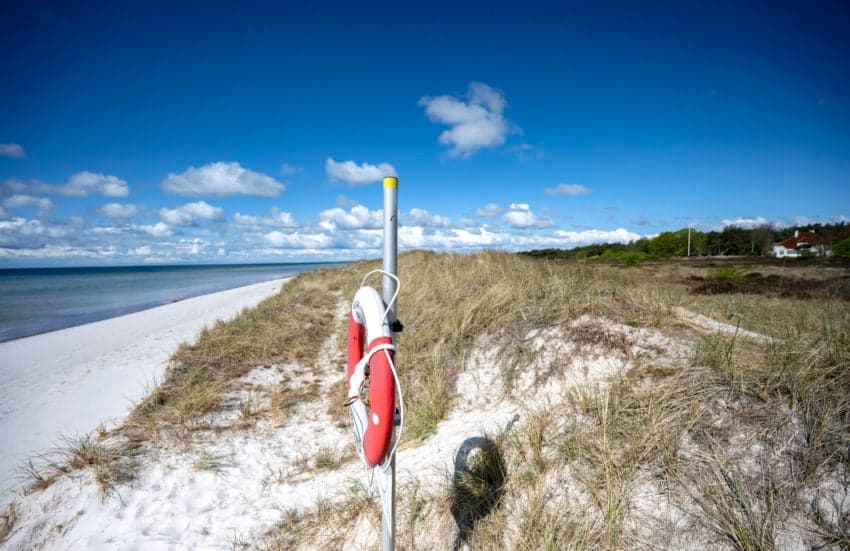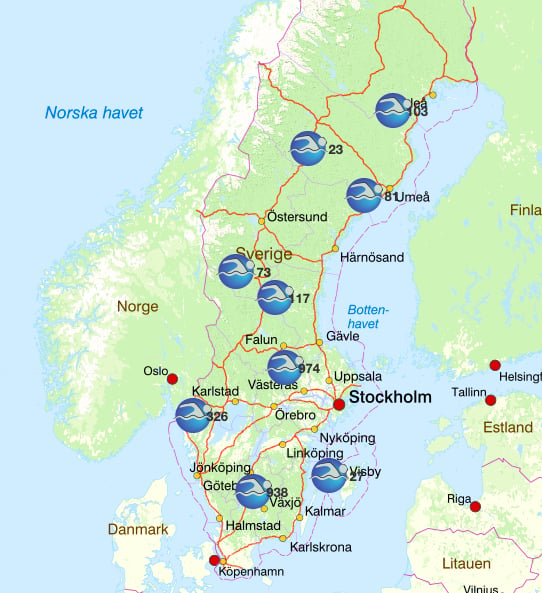How to find Sweden's cleanest and best beaches in the summer of 2022

Although most Swedes are back at work by now, that doesn't mean summer's over. Here's how to find the country's cleanest and best beaches to visit on your next day off.
The number of beaches in Sweden which are checked and graded is growing every year, making it easy to make sure that where you are swimming is clean and safe.
The number of 'EU bathing spots', which are monitored as part of the union's clean bathing water scheme, increased to 457 this year from the 445 registered last summer, according to a press release issued in June by the Swedish Agency for Marine and Water Management.
At the same time, 14 harbours and seven beaches in Sweden qualified this year for the international Blue Flag scheme, which is awarded to beaches and small ports with a high level of environmental friendliness, water quality and safety.
For a bathing spot to qualify for the EU scheme, more than 200 people must swim there a day on average during the bathing season. The local municipality is then responsible for checking the water quality and posting the results up on a sign at the beach.
This year, 356 of the Swedish bathing spots, or about 78% qualified as having "excellent quality", the highest possible classification, whereas 89 percent had "good quality".
The bad news this year is that the number of bathing spots which have received the worst "poor quality" classification has risen to 15, up from only one back in 2019, something Emma Glad, the agency's beach investigator, said could be connected to the Covid-19 pandemic.
Bathing spots get a "poor quality" rating if levels of bacteria from human and animal faeces are too high, leading to a risk that swimmers get infected with E. coli or other bacteria.
Because so many people holidayed at home in Sweden in 2020 and 2021, she said, there were more visits to beaches. The number of dogs in Sweden also rose during the pandemic, increasing the risk that dog poo gets into the water.
Finally, heavy rain may have led sewage to spill into the sea at some spots.
You can find the quality classification, algae levels, and even the water temperature of swimming spots near you on the agency's interactive map, which you can find here.

Source: Screenshot/Swedish Agency for Marine and Water Management.
Blue flag beaches
Here is a list of the beaches and harbours in Sweden which have received the blue flag certification.
Harbours:
Båstad Hamn
Båtfjordens hamn
Burgsviks hamn
Fyruddens hamn, Gryt
Gästhamnen Stavsnäs
Gävle Gästhamn
Getterön Marina, Varberg
Hälleviks Hamn, Sölvesborg
Heleneborgs Båtklubb, Stockholm
Torekovs hamn,Torekov
Pampas Marina, Solna
Trosa Gästhamn
Uvmarö Hamn
Varbergs innerhamn
Beaches
Falsterbo strandbad
Kämpinge strandbad, Höllviken
Lagunen Camping, Strömstad
Långa Bryggan, Bjärred
Rydebäcksstranden, Rydebäck
Skanörs havsbad, Skanör
Trosa Havsbad
Comments
See Also
The number of beaches in Sweden which are checked and graded is growing every year, making it easy to make sure that where you are swimming is clean and safe.
The number of 'EU bathing spots', which are monitored as part of the union's clean bathing water scheme, increased to 457 this year from the 445 registered last summer, according to a press release issued in June by the Swedish Agency for Marine and Water Management.
At the same time, 14 harbours and seven beaches in Sweden qualified this year for the international Blue Flag scheme, which is awarded to beaches and small ports with a high level of environmental friendliness, water quality and safety.
For a bathing spot to qualify for the EU scheme, more than 200 people must swim there a day on average during the bathing season. The local municipality is then responsible for checking the water quality and posting the results up on a sign at the beach.
This year, 356 of the Swedish bathing spots, or about 78% qualified as having "excellent quality", the highest possible classification, whereas 89 percent had "good quality".
The bad news this year is that the number of bathing spots which have received the worst "poor quality" classification has risen to 15, up from only one back in 2019, something Emma Glad, the agency's beach investigator, said could be connected to the Covid-19 pandemic.
Bathing spots get a "poor quality" rating if levels of bacteria from human and animal faeces are too high, leading to a risk that swimmers get infected with E. coli or other bacteria.
Because so many people holidayed at home in Sweden in 2020 and 2021, she said, there were more visits to beaches. The number of dogs in Sweden also rose during the pandemic, increasing the risk that dog poo gets into the water.
Finally, heavy rain may have led sewage to spill into the sea at some spots.
You can find the quality classification, algae levels, and even the water temperature of swimming spots near you on the agency's interactive map, which you can find here.

Blue flag beaches
Here is a list of the beaches and harbours in Sweden which have received the blue flag certification.
Harbours:
Båstad Hamn
Båtfjordens hamn
Burgsviks hamn
Fyruddens hamn, Gryt
Gästhamnen Stavsnäs
Gävle Gästhamn
Getterön Marina, Varberg
Hälleviks Hamn, Sölvesborg
Heleneborgs Båtklubb, Stockholm
Torekovs hamn,Torekov
Pampas Marina, Solna
Trosa Gästhamn
Uvmarö Hamn
Varbergs innerhamn
Beaches
Falsterbo strandbad
Kämpinge strandbad, Höllviken
Lagunen Camping, Strömstad
Långa Bryggan, Bjärred
Rydebäcksstranden, Rydebäck
Skanörs havsbad, Skanör
Trosa Havsbad
Join the conversation in our comments section below. Share your own views and experience and if you have a question or suggestion for our journalists then email us at [email protected].
Please keep comments civil, constructive and on topic – and make sure to read our terms of use before getting involved.
Please log in here to leave a comment.